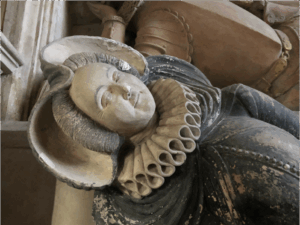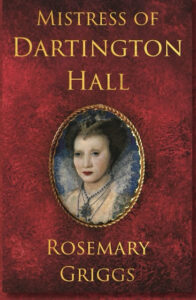Daughters of Devon
For my Daughters of Devon series, I draw inspiration from the lives of intriguing, lesser-known women who lived in 16th-century Devon. I’m particularly fascinated by the characters associated with Dartington Hall. One woman, Lady Gabrielle Roberda Montgomery (Roberda), especially captured my imagination.
Roberda’s story doesn’t begin in Devon, but in Normandy, France. Her father, Gabriel de Lorges, Comte de Montgomery, killed the King of France in a jousting accident. Gabriel converted to the Protestant faith and became a prominent Huguenot general during the wars of religion. His wife, Isabeau de la Touche, took all her children with her as she followed him on the campaign trail. She even led them into the heart of the Siege of Rouen. So, Roberda’s childhood unfolded against the backdrop of a country ravaged by war, until, in 1571, she married Sir Arthur Champernowne’s eldest son, Gawen.
Sir Arthur was a staunch Protestant. He funded his nephew, Henry Champernowne, to take around 100 young men from Devon to fight alongside the Huguenots. Among them was a young Walter Raleigh, another of Sir Arthur’s nephews.
In 1547, Sir Arthur married Mary Norreys. She was the daughter of Henry Norreys, executed after being accused of adultery with Anne Boleyn. Mary’s first husband, Sir George Carew (Sir Arthur’s cousin), died with the sinking of the Mary Rose. Some years after their marriage, Arthur and Mary traded Polsloe Priory for Dartington. John Holand, the half-brother of King Richard II, built the magnificent late 14th-century manor house, and the Champernownes lived there until 1925.
Mary died in 1570. So when Roberda arrived a year later as Gawen Champernowne’s bride, she became Mistress of Dartington Hall. Managing the household must have been a daunting task. Like many women of her time, when Gawen was away on the Queen’s business, she also had to manage the wider estate. However, the records suggest Roberda was resolute and had likely been well-trained by her mother. Despite the challenges of an appallingly difficult marriage to the ambitious Gawen, she persevered.
After they narrowly escaped the dreadful events of the St Bartholomew’s Day Massacre, Sir Arthur welcomed the Montgomery family to Dartington as refugees.Gabriel granted Isabeau power of attorney over his affairs and estates while he fought in the wars. This was a most unusual step. Isabeau managed the estates well and also secured supplies and weapons for the Huguenot army. Both Gabriel and his wife visited Queen Elizabeth’s court several times. Roberda’s mother stayed in England for some years after Gabriel’s execution in France in 1574, spending some of that time at Dartington. She was at court in 1576, when at the New Year’s gift exchanges, she gave the Queen pillowcases embroidered with gold and silver and edged with white bone lace.
In my telling of the story, Roberda finds a true friend in Gawen’s sister, Elizabeth Champernowne (Bess). After being betrothed for a long time, Bess married Edward Seymour of nearby Berry Pomeroy Castle. Edward was Protector Edward Seymour’s son from his first marriage. Bess, who spent her childhood at Dartington, is the only one of these women for whom an image survives.

This is her effigy, which lies beneath those of her husband and father-in-law, in St Mary’s Church, Berry Pomeroy. Bess had at least nine children.
Katherine Raleigh, from my first book, never lived at Dartington, but it is likely she often visited. Katherine has become my alter ego and won’t leave me alone. I often find her tugging at my elbow, whispering in my ear, “I was there when that happened.” She makes several cameo appearances in Roberda’s story.
Women whose names appear in the historical record also inspired some servants who appear as supporting characters in my novels. For example, the Church Consistory Court’s records name Alice Blackaller as a servant at Dartington Hall, and her family name appears often in parish records in Dartington and nearby villages. In my novel, Alice is a gossipy busybody, who adds a touch of comedy to some tense situations. I also modelled Marie Weare, portrayed as an expert needlewoman, after a real person of that name who served in the Champernowne household.
 MISTRESS OF DARTINGTON HALL
MISTRESS OF DARTINGTON HALL
The Dartington Bride follows Roberda through her traumatic childhood and the early years of her unfortunate marriage. The recently published sequel, Mistress of Dartington Hall, picks up the story when Devon is on a knife-edge as the Spanish Armada prepares to unleash destruction on the land. In the event, the Spanish warships sailed on up the English Channel. Devon was safe However, Roberda had many more trials to face before finding fulfilment. All later records refer to Roberda by her French title, as Lady Gabrielle Montgomery. That suggested to me that she became a strong and independent woman.
1587. England is at war with Spain. The people of Devon wait in terror for King Philip of Spain’s mighty armada to unleash untold devastation on their land.
Roberda, daughter of a French Huguenot leader, has been managing the Dartington estate in her estranged husband Gawen’s absence. She has gained the respect of the staff and tenants who now look to her to lead them through these dark times.
Gawen’s unexpected return from Ireland, where he has been serving Queen Elizabeth, throws her world into turmoil. He joins the men of the west country, including his cousin, Sir Walter Raleigh, and his friend, Sir Francis Drake, as they prepare to repel a Spanish invasion. Amidst musters and alarms, determined and resourceful Roberda rallies the women of Dartington. But, after their earlier differences, can she trust Gawen? Or should she heed the advice of her faithful French maid, Clotilde?
Later Roberda will have to fight if she is to remain Mistress of Dartington Hall, and secure her children’s inheritance. Can she ever truly find fulfilment for herself?
Praise for Daughters of Devon Series:
“Rosemary Griggs has created a fascinating niche within the historical fiction genre with her ‘Daughters of Devon’ series of novels. She focuses on the noble women now almost forgotten by the history books.”


Thank you so much for hosting Rosemary Griggs today, with such an interesting article linked to her compelling new novel. Mistress of Dartington Hall.
Take care,
Cathie xx
The Coffee Pot Book Club